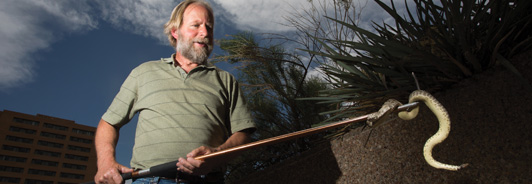Charmed by Snakes: Professor Eyes Venoms for Treatment Options
By Dan England
Photography by Eric Bellamy
Steve Mackessy walks across the scrubby field like a city dweller headed to a deal, probably the way he did when he was a kid hunting for snakes in the southern California mountains.
The field, deep in the heart of Weld County, resembles much of the country near the Pawnee National Grassland: brown, dusty and littered with tumbleweeds but dotted with greenery and bluffs. It’s certainly not among the exotic locations Mackessy visits as one of the world leaders in snake venom research.
Yet just as Mackessy walks with a purpose — you have to hustle to keep up with him — he pauses by every prairie dog hole and scrapes under piles of brush with the stick of a snake handler.
The area is home to the prairie rattlesnake, and that rattlesnake is as important to him as the cow to a dairy farmer (Mackessy likes to compare venom to milk, calling it a renewable resource.) Even though it becomes obvious the snakes just aren’t out this morning, the UNC professor of Biology doesn’t want to leave. There’s always another hole to check.
When he does return to his Ross Hall lab, Mackessy — who eschews a white coat for a Columbia button-up shirt and greets people with a “hey, man” — will slip into a researcher’s role easily. He studies proteins in venom that may help us — from fighting blood clots to aiding digestion and even battling cancer.
Many proteins in venom have similar qualities among all snakes, but the individual differences in those proteins can be the bull’s-eye, even among different kinds of rattlesnakes. Recognizing the differences, and pinpointing them, is the tricky part. The same three-fingered protein from a cobra can paralyze prey and attract mates, two radically different objectives. To successfully treat cancer, a protein may be just different enough to attack the disease, rather than leave it unscathed. Mackessy’s job is to narrow and pinpoint those compounds that could be useful as drugs, though he would never make the drug himself.
Mackessy first made a name for himself for his research on blood clots before moving on to cancer. For a segment on the Discovery Channel, he also showed how venom could aid in the snake’s digestion. Though many worked on venom and blood clots before him, the cancer research is newer and more personal. Doctors removed a spot on his back, another on his temple, and he bears a tiny scar on his nose from a minor operation there as well. He doesn’t regret those days in southern California looking for critters. That’s a big reason why he does what he does now. He just wishes he knew more about sunscreen back then.
Research is time consuming, and sometimes, to do it right, it can be a full-time job. But Mackessy wouldn’t want to work in research full-time, even when he still, at age 57, feels as if he’s in danger of burning the candle on both ends because of his teaching career.
“Unless you don’t sleep,” he says, “it makes it a challenge.”
He continually proves himself, says acting assistant vice president for research Teresa M. McDevitt. He’s published more than 60 articles in the most prestigious outlets and presented in Malaysia, Singapore, Vietnam and parts of Europe, Costa Rica and Canada. This fall, he’ll go to South America for the first time. Students in his classes and graduate students join him in the field, as they did for studies from 1994-97 and 2000-02 with the state to record and establish numbers of reptiles and amphibians in eastern Colorado.
Two years ago, UNC gave him the M. Lucile Harrison Award, the university’s top faculty honor.
“The technical aspects of his work are well-regarded,” McDevitt says. “But he’s able to bring that alive to students. That’s an exceptional ability to be able to reach out and motivate at so many different levels.”
The state is indebted to his work with reptile populations, but his studies of the desert massasauga are the most invaluable, says Tina Jackson, who is in charge of monitoring the reptile population for Colorado Parks and Wildlife. Mackessy prefers to give credit to a rancher in southeastern Colorado for allowing the studies, but by fall 2007, all that work yielded 1,800 records of the massasauga. Before the studies began, there were only two dozen known sightings of the snake.
“You have to be in the right place at the right time to see them,” he says. The work will help the state convince the U.S. Fish and Wildlife Service that the massasauga won’t need to be listed as endangered and therefore dodge additional costly regulations.
Back in Weld County, Mackessy keeps secret his prime spots to find prairie rattlesnakes, as if they were codes to a few of the nuclear weapons buried out in that prairie.
“People will come out to catch them, or kill them, or God knows what else,” he says. “It’s really unfortunate. They are these really beautiful and interesting creatures.”
They are also useful, Mackessy said, and his work attempts to prove that. It’s also proof that conservation and finding the good in creatures such as snakes, even if they appear scary, can benefit us with cures for diseases such as cancer.
“It doesn’t have to be from a tree-hugging perspective,” he says. “I don’t mind exploring and using how they benefit us.”
And yet, Mackessy smiles when he talks about his conservation efforts, and he looks up for a second at the large rattlesnake photo in his office.
“Though I am more of the tree hugger,” he says.







